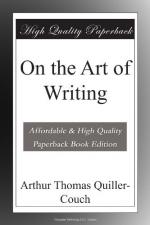What am I urging? ’That Style in writing is much the same thing as good manners in other human intercourse?’ Well, and why not? At all events we have reached a point where Buffon’s often-quoted saying that ’Style is the man himself’ touches and coincides with William of Wykeham’s old motto that ‘Manners makyth Man’: and before you condemn my doctrine as inadequate listen to this from Coventry Patmore, still bearing in mind that a writer’s main object is to impress his thought or vision upon his hearer.
’There is nothing comparable for moral force to the charm of truly noble manners....’
I grant you, to be sure, that the claim to possess a Style must be conceded to many writers—Carlyle is one—who take no care to put listeners at their ease, but rely rather on native force of genius to shock and astound. Nor will I grudge them your admiration. But I do say that, as more and more you grow to value truth and the modest grace of truth, it is less and less to such writers that you will turn: and I say even more confidently that the qualities of Style we allow them are not the qualities we should seek as a norm, for they one and all offend against Art’s true maxim of avoiding excess.
And this brings me to the two great paradoxes of Style. For the first (1),—although Style is so curiously personal and individual, and although men are so variously built that no two in the world carry away the same impressions from a show, there is always a norm somewhere; in literature and art, as in morality. Yes, even in man’s most terrific, most potent inventions—when, for example, in “Hamlet” or in “Lear” Shakespeare seems to be breaking up the solid earth under our feet—there is always some point and standard of sanity—a Kent or an Horatio—to which all enormities and passionate errors may be referred; to which the agitated mind of the spectator settles back as upon its centre of gravity, its pivot of repose.




